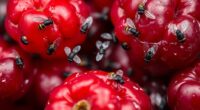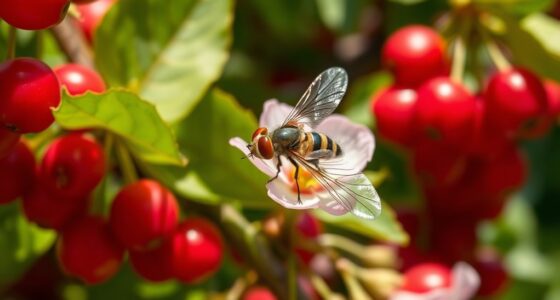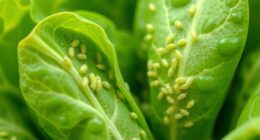Peach tree borer signs include D-shaped exit holes in the bark, sawdust-like frass around the base, and tunneling beneath the bark that causes damage and decay. You’ll notice these during late spring and early summer when larvae hatch and adults lay eggs. Monitoring for fresh exit holes, frass, and tunneling early in the season helps catch infestations early. Keep going to discover more about timing and effective natural control methods.
Key Takeaways
- Look for D-shaped exit holes and sawdust-like frass at the base or trunk of the peach tree.
- Detect tunneling or damage beneath bark during late spring or early summer.
- Observe fresh exit holes and frass accumulation as early signs of infestation.
- Apply natural remedies like neem oil during the dormant season for prevention.
- Monitor pest activity during late spring and early summer to time control measures effectively.

The peach tree borer is a common pest that can cause serious damage to stone fruit trees if not managed properly. Recognizing this pest early is vital for effective control. Pest identification involves looking for specific signs, such as D-shaped exit holes in the bark, sawdust-like frass around the base of the tree, and damage beneath the bark, including tunneling and decay. The adult borer is a wasp with a metallic sheen, but it’s the larval stage that causes the most harm by burrowing into the trunk and disrupting the flow of nutrients and water.
Early signs of peach tree borer include D-shaped exit holes, sawdust-like frass, and bark tunneling.
To effectively combat the peach tree borer, you need to understand its life cycle and the best timing for intervention. The larvae typically hatch in late spring or early summer when the adult moths lay eggs on the bark of the tree. Knowing this timing helps you target your pest control efforts more effectively. If you notice fresh damage or new exit holes during this period, it’s a good sign that the pests are active and that you should implement control measures promptly.
When it comes to natural remedies, there are several strategies you can use to manage this pest without resorting to chemicals. One effective method is to apply horticultural oils or neem oil during the dormant season, which can smother overwintering larvae and reduce future populations. Another natural approach involves physically removing infested bark or pruning out infested branches, especially if you catch the problem early. Wrapping the trunk with sticky traps or bands coated with a natural sticky substance can help catch adult moths before they lay eggs. Additionally, maintaining tree health through proper watering, fertilization, and pruning can make your trees less attractive to pests and improve their resilience. Regularly inspecting your trees during the growing season helps you catch early signs of infestation, allowing you to act swiftly with natural remedies before the damage becomes severe. Understanding pest life cycles and timing treatments accordingly greatly enhances your chances of successful control.
Frequently Asked Questions
Can Peach Tree Borers Affect Other Fruit Trees?
Yes, peach tree borers can affect other fruit trees, especially if they share alternative host plants nearby. These pests are not exclusive to peaches and can infest other stone fruits like plums and apricots. To protect your trees, you should implement pest management strategies, including monitoring for signs of infestation and applying appropriate treatments. Regular inspection and early intervention are key to preventing widespread damage from peach tree borers.
What Natural Predators Help Control Peach Tree Borer Populations?
You can rely on beneficial insects for predator control of peach tree borers. Natural predators like parasitic wasps, such as Trichogramma and Braconid wasps, help keep borer populations in check. These beneficial insects lay their eggs inside borer larvae or pupae, disrupting their development. To enhance predator control, avoid broad-spectrum pesticides that harm these helpful insects, and consider releasing or encouraging their presence around your trees.
Are There Organic Methods to Prevent Peach Tree Borer Infestation?
You can totally stop peach tree borers with organic prevention methods! Use beneficial insects like Trichogramma wasps, which are tiny warriors that prey on borer eggs. Apply organic insecticidal oils to smother larvae and create a barrier around your tree’s base. Regularly inspect your tree, keep it healthy with proper watering and pruning, and watch these natural defenders work wonders—your tree will thank you!
How Long Does the Peach Tree Borer Lifecycle Typically Last?
The borer lifecycle duration usually lasts about one year, but it can vary depending on climate conditions. You’ll notice the pest goes through several development stages, including eggs, larvae, pupae, and adults. The larvae stage is when they cause the most damage, tunneling into the tree trunk. Knowing this timeline helps you time your organic prevention methods, like applying beneficial nematodes or sticky traps, more effectively.
Does Weather Impact the Timing of Peach Tree Borer Activity?
Weather influence is like a conductor guiding the orchestra of nature, and seasonal variation sets the tempo. You’ll notice that warmer, milder winters may awaken peach tree borer activity earlier, while colder spells can delay it. Sudden temperature swings also influence their lifecycle, causing fluctuations in activity. So, yes, weather greatly impacts their timing, making it essential to monitor seasonal shifts closely to protect your trees effectively.
Conclusion
By staying alert for signs, monitoring timing, and taking prompt action, you safeguard your peach trees from damage. Recognize the signs early, act at the right moments, and prevent further infestation. Keep your trees healthy, your harvest bountiful, and your orchard thriving. With careful observation, timely intervention, and consistent care, you guarantee your peach trees remain strong, fruitful, and free from the destructive reach of the peach tree borer.









